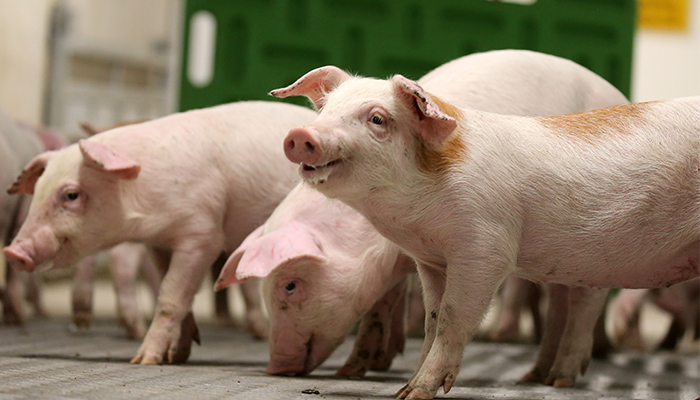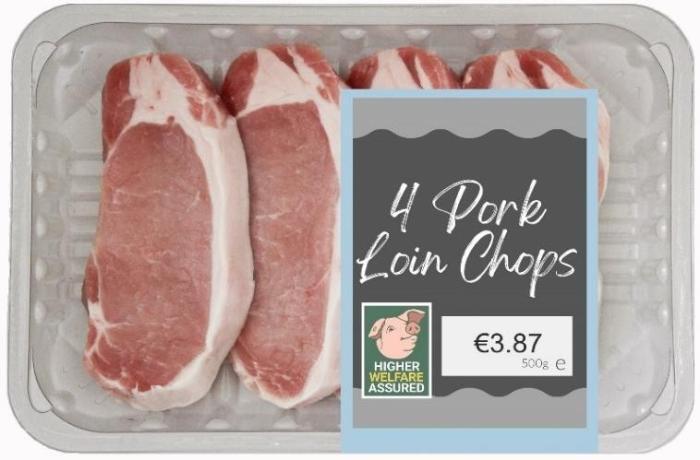05 January 2024
Adding value to pig meat: What is important to consumers?

Molly Harrison, Teagasc Pig Development Department, discusses a study on consumer preferences for pig meat products, focusing on the impact of assurance labels, such as welfare and sustainability labels, on purchasing decisions.
Consumers are increasingly conscious of how their food is produced, so a recent study in the PDD investigated how this applies to pig meat. We carried out an online survey of approximately 800 pig meat consumers from Ireland and the UK, across a range of backgrounds and demographics. This included 9 mock-ups of different pig meat products (ham, bacon, and pork chops) that had a range of assurance labels on the packaging (none, welfare or sustainably produced), and at a range of price levels: average Irish price, 10% increase, and 40% increase. Each product had a different combination of characteristics (Table 1), with an example in Figure 1.
Table 1. The combinations of product characteristic used to create the nine product images in the survey.
| Assurance Label | Product Type | Price |
| No Label | Pork Chops | > 40% |
| Bacon | >15% | |
| Ham | Standard | |
| Sustainably Produced | Bacon | > 40% |
| Ham | > 15% | |
| Pork Chops | Standard | |
| Pig Welfare | Ham | > 40% |
| Pork Chops | > 15% | |
| Bacon | Standard |
The ‘pig welfare’ label was defined as: “a label used on products that come from farms that have been certified to have met the assurance scheme’s high standards of welfare. These standards are higher than the minimum standards set in the law”.
The sustainably produced label was defined as: “a label used on products that come from farms that have been certified to have met the assurance scheme’s
sustainability standards. The standards include different aspects of sustainability such as how much the production of the product impacts the environment and the business’s ethics”.

Figure 1. Example of one of the product mock ups.
Consumers were asked how likely they would be to purchase each of the 9 mocked up products on a scale of 0 (‘would definitely not purchase’) to 10 (‘would definitely purchase’). The importance and value consumers placed on the product characteristics was then statistically investigated. Overall, assurance labels were found to be the most important factor to consumers, then product type, then price.
Overall, we found most value was placed on the animal welfare label, and least on products with no label.
| Price | Product Type | Assurance Label |
|---|---|---|
| 18.7% | 32.8% | 48.5% |
Price was persistently valued negatively by the respondents, and progressively more so as the price increased. Interestingly, Irish consumers had a stronger negative preference for products with no labels than those with either of the two options (sustainability or welfare) and they also more positively valued bacon over ham and pork chops.
Although there were some minor differences between the responses from UK and Irish consumers, in general the results from both countries were very similar, so we were able to
include all respondents in one analysis to identify different types of ‘consumer group’. We were able to identify three distinct groups, on the basis of how much they valued the different product characteristics, which we named as ‘indifferent’ consumers, consumers that ‘like labels’, and ‘pro pig welfare’ consumers (Table 2).
Overall, 32% of the sample, had a strong preference for welfare labelled pig meat products. Within this group the ‘like labels’ group also found pigmeat with a sustainably produced label to be favourable. Although we have to acknowledge that these data are based upon hypothetical survey data, these results do suggest a market for these types of products, in particular because the attitudes of Irish consumers was similar to those in the UK, where such labelled products hold a significant market share.
Table 2. Characteristics of the Different Consumer Groups
|
‘Indifferent’ Consumers 68% of the total |
‘Pro Pig Welfare’ Consumers 9% of the total |
‘Like Labels’ Consumers 23% of the total |
|
Did not really value any of the product characteristics that were assessed. |
Really positively valued the pig welfare label, had a negative value for the ‘sustainably produced’ label. |
Most negatively valued products without a label and positively valued the pig welfare label and to a slightly lesser extent, the ‘sustainably produced’ label. |
|
Most likely to buy products with no assurance label and most valued the product type bacon. |
Most likely to buy ‘pig welfare’ labelled products and most valued the product type ham. |
Most likely to buy ‘sustainably produced’ labelled products and most valued the product type pork chops. |
|
More likely to be from an urban area, to be male, ‘pig welfare’ products are out of their budget, trust product labels less, and feel less moral responsibility towards the products they buy than the ‘like labels’ group. |
Bought pig meat more frequently than the indifferent group. |
More likely to be from a rural area, to be female, to trust product labels, to feel ‘pig welfare’ products are within their budget and that they have a moral responsibility to purchase them than the indifferent group. |
|
Had less intention to buy ‘pig welfare’ products, and less knowledge of pigs than the other groups. |
Both of these groups had a higher intention to buy ‘pig welfare’ labelled products, were less likely to think pig welfare is not a priority and had more knowledge of pig welfare and production, than the indifferent group. |
|
